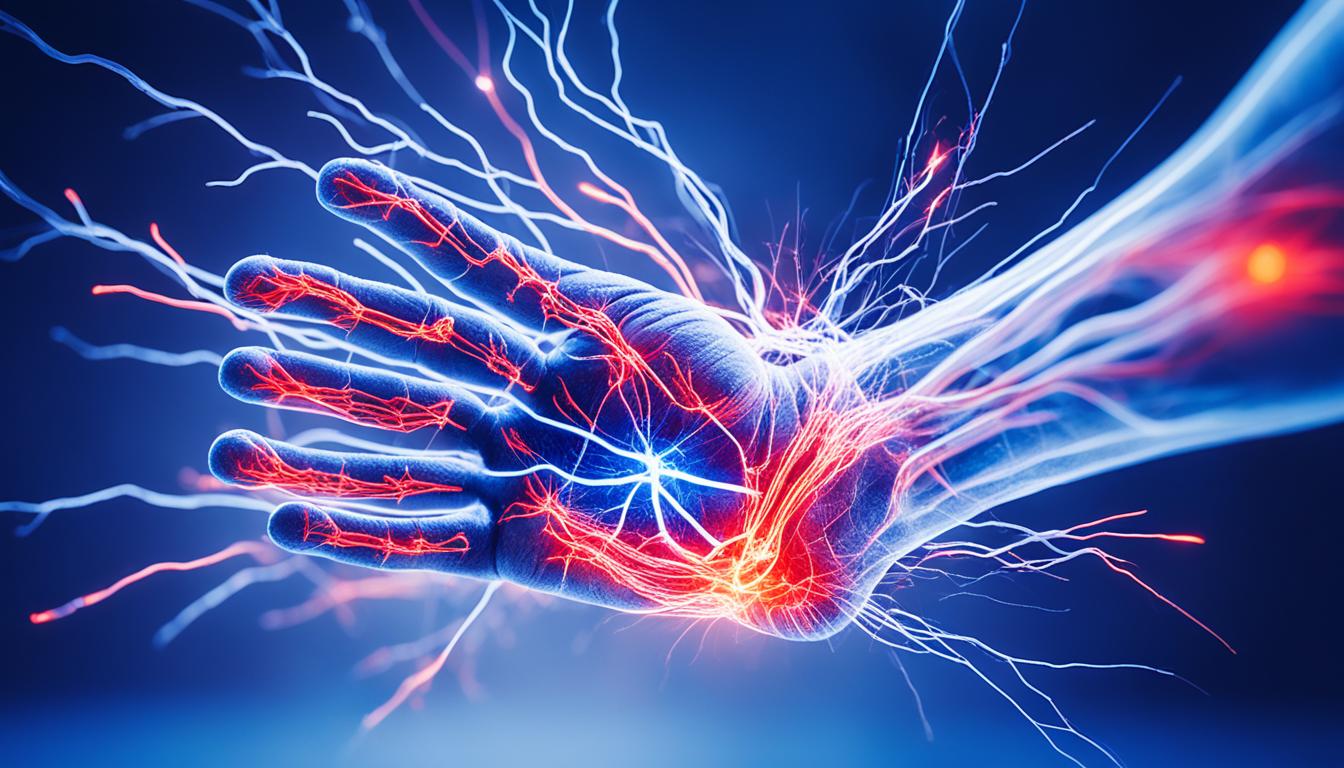Hereditary Motor and Sensory Neuropathy (HMSN) impacts the motor and sensory nerves. It’s also called Charcot-Marie-Tooth disease. It affects about 1 in every 2500 people. This condition leads to weakness, muscle loss, and decreased reflexes in the lower limbs. Over time, it can affect the arms and certain leg muscles.
HMSN causes a slow, progressive loss of certain sensations. Each type of Charcot-Marie-Tooth disease has its own way of being passed down. For example, many CMT type 1 cases are from a dominant gene from a parent.
Diagnosing HMSN often requires genetic testing. This is because specific gene mutations link to the disease. Although there’s no cure for HMSN yet, stem cell therapy offers hope in repairing nerve damage.
Key Takeaways
- Hereditary Motor and Sensory Neuropathy (HMSN) is a group of genetic disorders that affect the motor and sensory peripheral nerves.
- Charcot-Marie-Tooth disease is the most frequent form of inherited peripheral neuropathy.
- HMSN is characterized by gradually progressive weakness, atrophy, and depressed reflexes in the feet and legs.
- Genetic testing is crucial for the diagnosis of HMSN, enabling the identification of specific gene mutations.
- Stem cell therapy in regenerative medicine holds promise for promoting nervous system regeneration in individuals with HMSN.
Understanding the Genetics of Charcot-Marie-Tooth Disease
Charcot-Marie-Tooth disease (CMT) is complex and affects the peripheral nerves. It’s linked to genes like PMP22, MPZ, GJB1, and MFN2. Mutations in these genes slow down protein production in nerve cells, causing nerve damage and CMT.
CMT’s inheritance can vary by subtype. Most CMT type 1 cases follow a pattern where you only need one bad gene to get sick. CMT X1, however, is more severe in males because it comes from the X chromosome. For CMT type 2, it’s mostly passed down from one parent, but some rare types need mutations from both.
Knowing CMT’s genetic roots is key to diagnosing and managing it. Genetic tests can pinpoint the exact gene issues linked to CMT. This helps in planning treatments and counseling patients and their families about the condition.
Genes Associated with Charcot-Marie-Tooth Disease
Below, you can see genes usually tied to different CMT subtypes:
| Gene | Common CMT Subtype |
|---|---|
| PMP22 | CMT1A, CMT1E, CMT1D |
| MPZ | CMT1B, CMT2I |
| GJB1 | CMTX1, CMT1X |
| MFN2 | CMT2A |
The table shows common gene-subtype links. There are many rare subtypes with other genetic ties not listed here.
The picture above shows how diverse and complex the genetics of Charcot-Marie-Tooth disease can be.
Symptoms and Progression of Charcot-Marie-Tooth Disease
Charcot-Marie-Tooth disease (CMT) varies based on its type. Its signs usually start in the first 10 years, but for some, they may show up later. This disease affects the feet, hands, and how we feel things.
Pes Cavus and Cold Feet
Pes cavus means having high-arched feet. It’s more obvious as kids grow. People with CMT often have cold feet because of bad circulation and nerve problems.
Muscle Weakness and Contractures
CMT often makes muscles, mainly in the hands, weak. This starts after 20. Over time, some might get contractures, which make muscles and tendons tight. This can change the shape of hands and feet, making it hard to move and do things.
Sensory Loss and Walking Aid
Feet and hands can lose their sense of touch, temperature, and pain because of CMT. Although it gets worse over time, losing the ability to walk is rare. But for some, using a walking aid can help with movement.
Having Charcot-Marie-Tooth disease can really change how someone lives. Yet, with the right care and help, people with CMT can stay active and happy.
The Potential of Stem Cell Therapy for Charcot-Marie-Tooth Disease
Research in regenerative medicine is changing how we treat Charcot-Marie-Tooth disease (CMT). The Regentime stem cell procedure is a standout. It has shown it can help people walk better and feel more.
This method uses a person’s own stem cells from their bone marrow. These cells are a special type that hasn’t fully formed yet. They are given to the patient through their spine and veins.
So, what does this do? It helps fix the body’s nervous system. Patients get stronger, feel more, and can do more things. A patient in one study got much better after the treatment.
More study is needed, but the Regentime stem cell procedure’s success is exciting. It might be a new way to help those with Charcot-Marie-Tooth disease. This new treatment gives hope for a better life for these patients.

